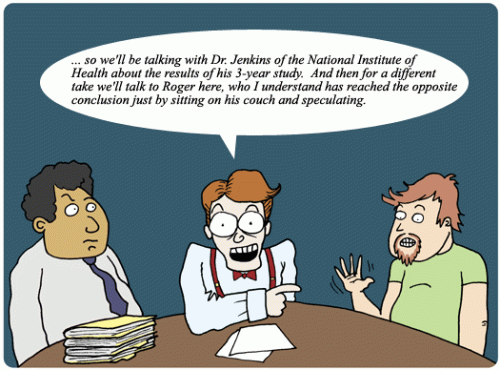by Tim Harding
False balance, is a form of deliberate or unintended media bias, in which opposing viewpoints are presented as being more balanced than the evidence warrants. The media gives weight to evidence and opinions out of proportion to the supporting evidence for each side, and/or withholds information that would establish one side’s claims as baseless. The impression is given of a scientific or evidence-based debate, where there is actually none. The fallacy is related to false equivalence, but is not quite the same.
Source: University of California Museum of Paleontology[1]
(used with permission)
This fallacy is also known as ‘Okrent’s law’ named after Daniel Okrent, the first public editor of The New York Times newspaper . He once said: “The pursuit of balance can create imbalance because sometimes something is true,” referring to the phenomenon of the press providing legitimacy to fringe or minority viewpoints in an effort to appear even-handed.
A notorious instance of false balance occurred on 16th August 2012, when WIN TV in Wollongong aired a news story about a measles outbreak in South-West Sydney. The story appeared to give equal weight to the professional advice of a medical practitioner that everyone should be immunised (against measles); versus an amateur opinion by Meryl Dorey of the so-called Australian Vaccination Network (AVN). Ms. Dorey claimed that ‘All vaccinations in the medical literature have been linked with the possibility of causing autism, not just the measles/mumps/rubella vaccine.’ The TV reporter concluded ‘Choice groups are calling for greater research into the measles vaccine’.
The ABC’s Media Watch program was scathing in its criticism of this news story:
‘Choice groups’. They actually only quoted one group, which claims that it’s in favour of the public having a choice. But Meryl Dorey’s deceptively-named Australian Vaccination Network is in fact an obsessively anti-vaccination pressure group that’s immunised itself against the effect of scientific evidence. Dorey’s claim about the medical literature linking vaccination and autism is pure, unadulterated baloney.[2]
On the Media Watch web site, there is a link to a long statement by the NSW Director of Health Protection, Dr. Jeremy McAnulty. Amongst other things, he says that:
Any link between measles vaccine and autism has been conclusively discredited by numerous in-depth studies and reviews by credible experts, including the World Health Organisation, the American Academy of Paediatrics and the UK Research Council. Statements erroneously linking measles vaccine and autism were associated with a decline in measles vaccination, which led to a measles outbreak in the UK in the past.[3]
Jonathon Holmes of Media Watch went on to say:
So why on earth, we asked WIN TV, did it include the AVN’s misleading claims in a news story about a measles outbreak?… Medical practitioners – choice groups. One opinion as valid as the other. It’s a classic example of what many – especially despairing scientists – call ‘false balance’ in the media…To put it bluntly, there’s evidence, and there’s bulldust. It’s a journalist’s job to distinguish between them, not to sit on the fence and bleat ‘balance’. Especially when people’s health is at risk.[2]
As the British Medical Journal put it last year in an editorial about the ‘debate’ in the UK:
The media’s insistence on giving equal weight to both the views of the anti-vaccine camp and to the overwhelming body of scientific evidence …made people think that scientists themselves were divided over the safety of the vaccine, when they were not. [4]
Other common examples of false balance in media reporting on science issues include the topics of man-made vs. natural climate change and evolution vs. creationism, as well as medicine vs quackery. As the Understanding Science web site says:
Balanced reporting is generally considered good journalism, and balance does have its virtues. The public should be able to get information on all sides of an issue — but that doesn’t mean that all sides of the issue deserve equal weight. Science works by carefully examining the evidence supporting different hypotheses and building on those that have the most support. Journalism and policies that falsely grant all viewpoints the same scientific legitimacy effectively undo one of the main aims of science: to weigh the evidence.[1]
False balance can sometimes originate from similar motives as sensationalism, where media producers and editors may feel that a story portrayed as a contentious debate will be more commercially successful to pursue than a more accurate account of the issue. However, unlike most other media biases, false balance may ironically stem from a misguided attempt to avoid bias; producers and editors may confuse treating competing views fairly—i.e., in proportion to their actual merits and significance—with treating them equally, by giving them equal time to present their views even when those views may be known beforehand to be based on false or unreliable information. In other words, two sides of a debate are automatically and mistakenly assumed to have equal value regardless of their respective merits.
References
[1] Beware of false balance: Are the views of the scientific community accurately portrayed? Understanding Science. University of California Museum of Paleontology. 25 February 2014 http://undsci.berkeley.edu/article/0_0_0/sciencetoolkit_04
[2] False Balance Leads To Confusion Media Watch Episode 35, 1 October 2012, ABC1. http://www.abc.net.au/mediawatch/transcripts/s3601416.htm
[3] Media Statement – Immunisation. Dr. Jeremy McAnulty, Director of Health Protection, NSW Health, 28th September, 2012.
[4] When balance is bias. British Medical Journal, Christmas Edition, 2011.
If you find the information on this blog useful, you might like to consider supporting us.



See: https://thelogicofscience.com/2022/01/14/joe-rogan-and-the-problem-of-false-balance/
LikeLike
ACMA investigation report: https://www.acma.gov.au/-/media/Broadcasting-Investigations/Investigation-reports/TV-investigations/Word-Document/2883-docx.docx?la=en
LikeLike
LikeLike
if this article about “false balance” is interesting to you, please consider liking the page “the skeptical paleontologist” on facebook.
LikeLike
See: https://theness.com/neurologicablog/index.php/bbc-and-false-balance-revisited/
LikeLike
Another one:
https://www.newstatesman.com/politics/media/2018/03/media-impartiality-problem-when-ignorance-given-same-weight-expertise
LikeLike
Another related article:
http://www.couriermail.com.au/rendezview/the-worrying-rise-of-the-armchair-expert/news-story/27af779b6c6101478685adef6f818d98
LikeLike
Here is a related article:
LikeLike
See: https://m.youtube.com/watch?v=ZI-Uu94vINg&feature=youtu.be
LikeLike
Pingback: false balance | bairninaus
I guess the ‘Complimentary and Alternative Therapy’ v ‘Medicine’ is a good example of false balance. As always, thanks for the logic.
LikeLiked by 1 person